COIT 20275: Functional Analysis and Allocation of Solar Power Report
VerifiedAdded on 2022/10/09
|13
|2974
|18
Report
AI Summary
This report provides a comprehensive analysis of Functional Analysis and Allocation (FA&A) within the context of solar power systems, specifically referencing the Dubai solar park project. It begins with an introduction to FA&A, outlining its purpose, inputs (customer requirements, available technology), and outputs (configuration data for product development). The report then details the staging of the system life cycle, including analysis of input processes and supporting processes like requirement analysis and system verification. It explores various approaches to functional analysis, such as requirement analysis, functional partitioning, timeline analysis, and functional block diagrams. Furthermore, the report examines functional allocation approaches, including design synthesis, functional architecture, and requirement allocation. The conclusion summarizes the key aspects of FA&A and highlights its importance in systems engineering, emphasizing methods like requirement allocation sheets, timeline analysis, and design synthesis. The report underscores the significance of FA&A in ensuring efficient and effective solar power system design, contributing to sustainable energy production and environmental benefits.
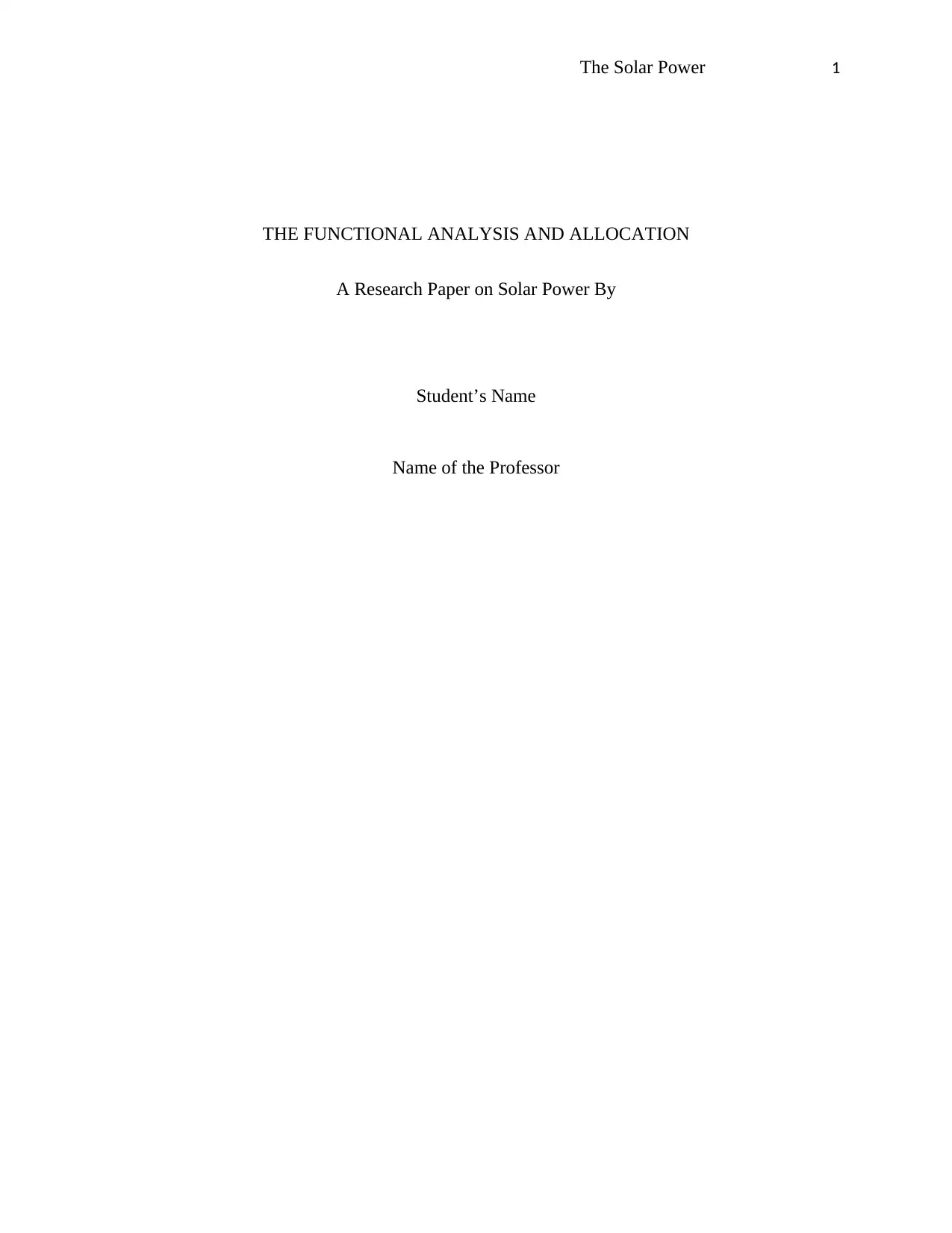
The Solar Power 1
THE FUNCTIONAL ANALYSIS AND ALLOCATION
A Research Paper on Solar Power By
Student’s Name
Name of the Professor
THE FUNCTIONAL ANALYSIS AND ALLOCATION
A Research Paper on Solar Power By
Student’s Name
Name of the Professor
Paraphrase This Document
Need a fresh take? Get an instant paraphrase of this document with our AI Paraphraser
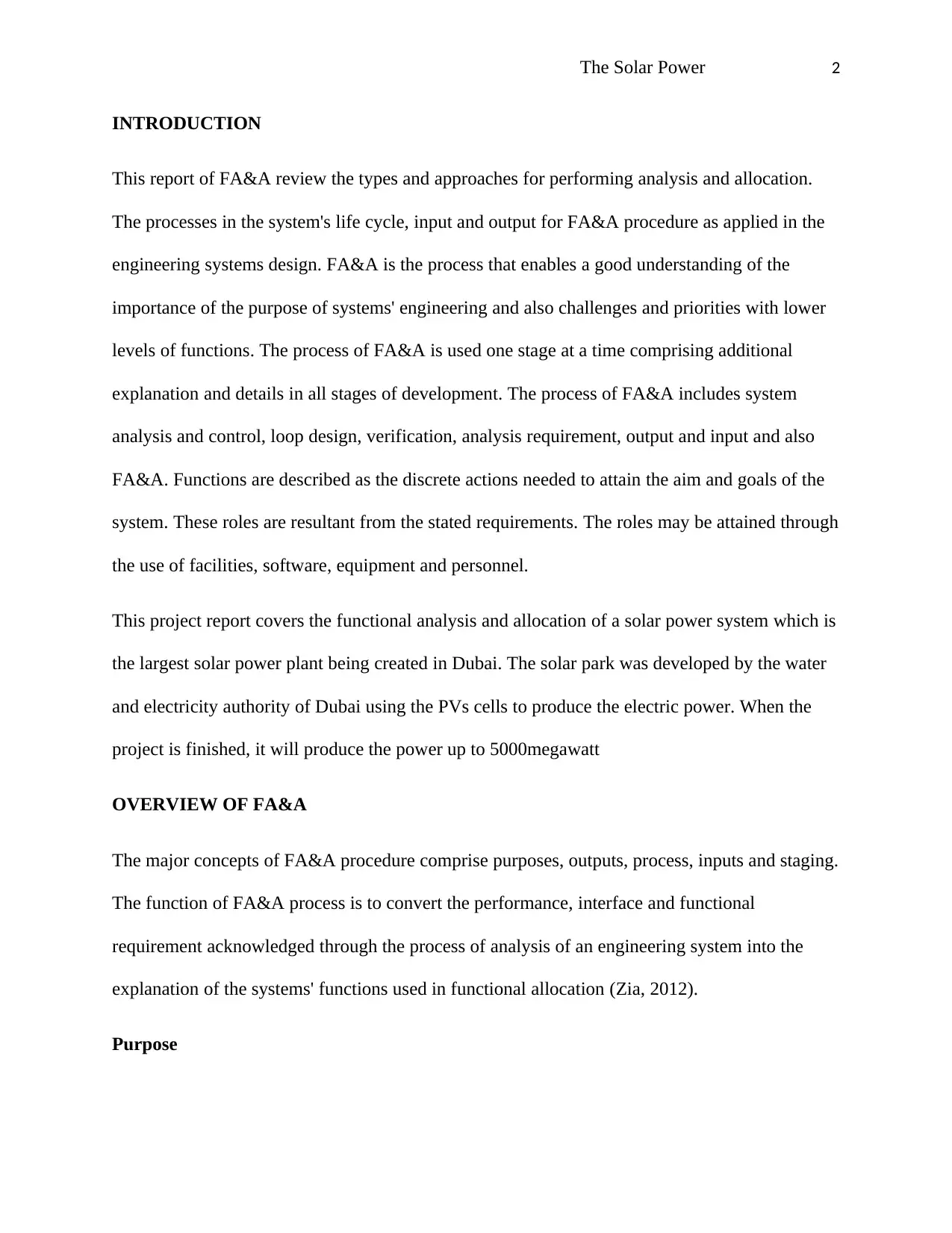
The Solar Power 2
INTRODUCTION
This report of FA&A review the types and approaches for performing analysis and allocation.
The processes in the system's life cycle, input and output for FA&A procedure as applied in the
engineering systems design. FA&A is the process that enables a good understanding of the
importance of the purpose of systems' engineering and also challenges and priorities with lower
levels of functions. The process of FA&A is used one stage at a time comprising additional
explanation and details in all stages of development. The process of FA&A includes system
analysis and control, loop design, verification, analysis requirement, output and input and also
FA&A. Functions are described as the discrete actions needed to attain the aim and goals of the
system. These roles are resultant from the stated requirements. The roles may be attained through
the use of facilities, software, equipment and personnel.
This project report covers the functional analysis and allocation of a solar power system which is
the largest solar power plant being created in Dubai. The solar park was developed by the water
and electricity authority of Dubai using the PVs cells to produce the electric power. When the
project is finished, it will produce the power up to 5000megawatt
OVERVIEW OF FA&A
The major concepts of FA&A procedure comprise purposes, outputs, process, inputs and staging.
The function of FA&A process is to convert the performance, interface and functional
requirement acknowledged through the process of analysis of an engineering system into the
explanation of the systems' functions used in functional allocation (Zia, 2012).
Purpose
INTRODUCTION
This report of FA&A review the types and approaches for performing analysis and allocation.
The processes in the system's life cycle, input and output for FA&A procedure as applied in the
engineering systems design. FA&A is the process that enables a good understanding of the
importance of the purpose of systems' engineering and also challenges and priorities with lower
levels of functions. The process of FA&A is used one stage at a time comprising additional
explanation and details in all stages of development. The process of FA&A includes system
analysis and control, loop design, verification, analysis requirement, output and input and also
FA&A. Functions are described as the discrete actions needed to attain the aim and goals of the
system. These roles are resultant from the stated requirements. The roles may be attained through
the use of facilities, software, equipment and personnel.
This project report covers the functional analysis and allocation of a solar power system which is
the largest solar power plant being created in Dubai. The solar park was developed by the water
and electricity authority of Dubai using the PVs cells to produce the electric power. When the
project is finished, it will produce the power up to 5000megawatt
OVERVIEW OF FA&A
The major concepts of FA&A procedure comprise purposes, outputs, process, inputs and staging.
The function of FA&A process is to convert the performance, interface and functional
requirement acknowledged through the process of analysis of an engineering system into the
explanation of the systems' functions used in functional allocation (Zia, 2012).
Purpose
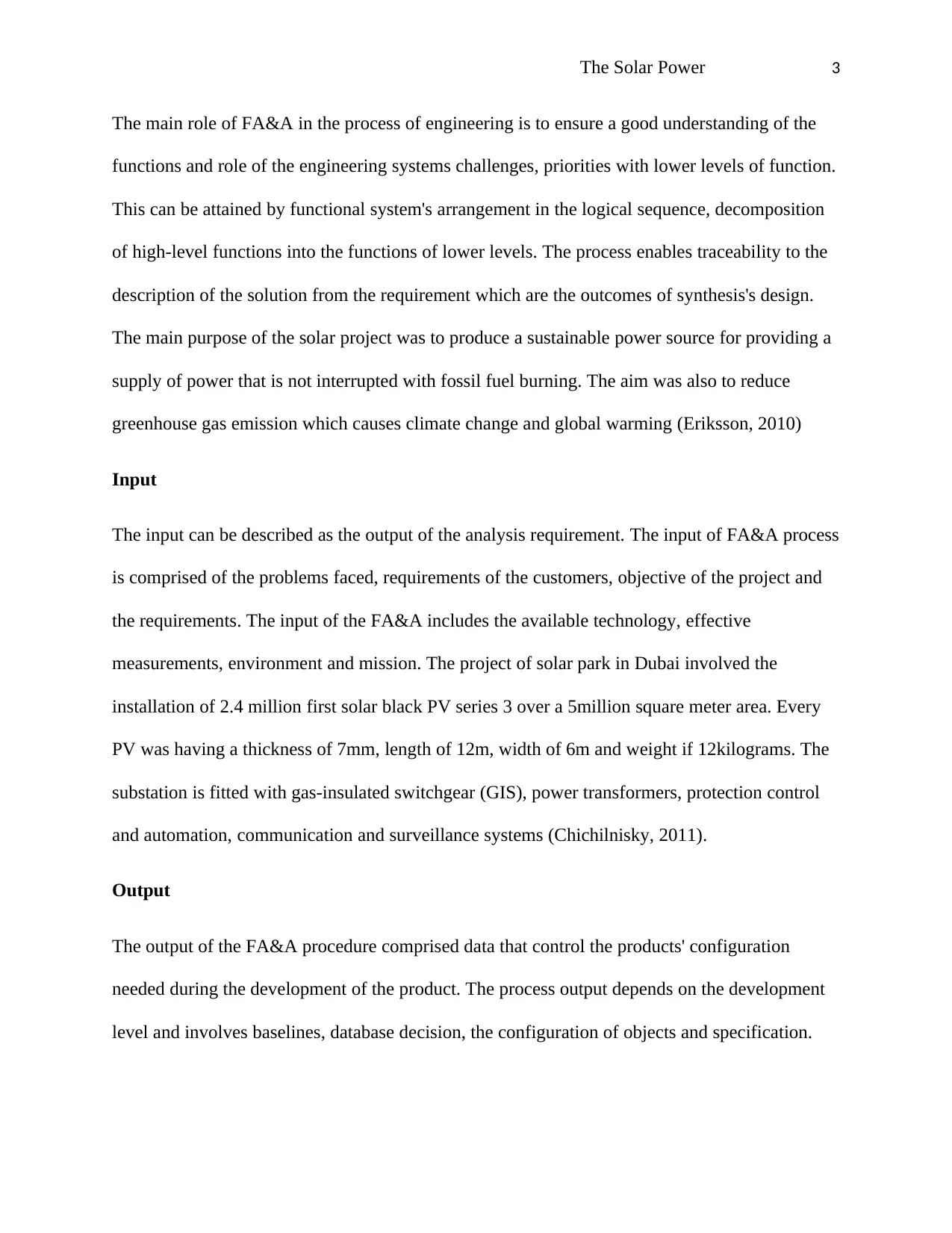
The Solar Power 3
The main role of FA&A in the process of engineering is to ensure a good understanding of the
functions and role of the engineering systems challenges, priorities with lower levels of function.
This can be attained by functional system's arrangement in the logical sequence, decomposition
of high-level functions into the functions of lower levels. The process enables traceability to the
description of the solution from the requirement which are the outcomes of synthesis's design.
The main purpose of the solar project was to produce a sustainable power source for providing a
supply of power that is not interrupted with fossil fuel burning. The aim was also to reduce
greenhouse gas emission which causes climate change and global warming (Eriksson, 2010)
Input
The input can be described as the output of the analysis requirement. The input of FA&A process
is comprised of the problems faced, requirements of the customers, objective of the project and
the requirements. The input of the FA&A includes the available technology, effective
measurements, environment and mission. The project of solar park in Dubai involved the
installation of 2.4 million first solar black PV series 3 over a 5million square meter area. Every
PV was having a thickness of 7mm, length of 12m, width of 6m and weight if 12kilograms. The
substation is fitted with gas-insulated switchgear (GIS), power transformers, protection control
and automation, communication and surveillance systems (Chichilnisky, 2011).
Output
The output of the FA&A procedure comprised data that control the products' configuration
needed during the development of the product. The process output depends on the development
level and involves baselines, database decision, the configuration of objects and specification.
The main role of FA&A in the process of engineering is to ensure a good understanding of the
functions and role of the engineering systems challenges, priorities with lower levels of function.
This can be attained by functional system's arrangement in the logical sequence, decomposition
of high-level functions into the functions of lower levels. The process enables traceability to the
description of the solution from the requirement which are the outcomes of synthesis's design.
The main purpose of the solar project was to produce a sustainable power source for providing a
supply of power that is not interrupted with fossil fuel burning. The aim was also to reduce
greenhouse gas emission which causes climate change and global warming (Eriksson, 2010)
Input
The input can be described as the output of the analysis requirement. The input of FA&A process
is comprised of the problems faced, requirements of the customers, objective of the project and
the requirements. The input of the FA&A includes the available technology, effective
measurements, environment and mission. The project of solar park in Dubai involved the
installation of 2.4 million first solar black PV series 3 over a 5million square meter area. Every
PV was having a thickness of 7mm, length of 12m, width of 6m and weight if 12kilograms. The
substation is fitted with gas-insulated switchgear (GIS), power transformers, protection control
and automation, communication and surveillance systems (Chichilnisky, 2011).
Output
The output of the FA&A procedure comprised data that control the products' configuration
needed during the development of the product. The process output depends on the development
level and involves baselines, database decision, the configuration of objects and specification.
⊘ This is a preview!⊘
Do you want full access?
Subscribe today to unlock all pages.

Trusted by 1+ million students worldwide
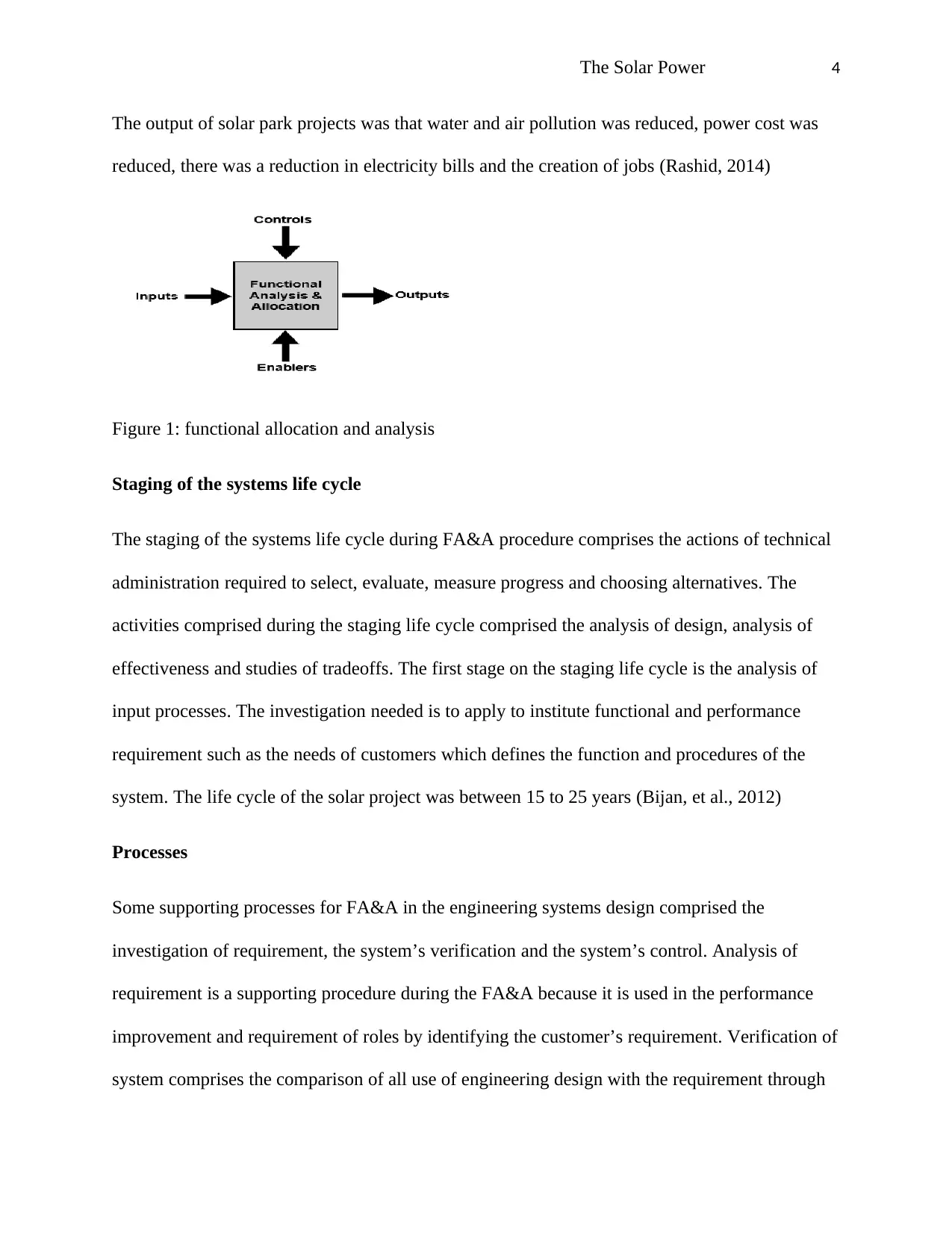
The Solar Power 4
The output of solar park projects was that water and air pollution was reduced, power cost was
reduced, there was a reduction in electricity bills and the creation of jobs (Rashid, 2014)
Figure 1: functional allocation and analysis
Staging of the systems life cycle
The staging of the systems life cycle during FA&A procedure comprises the actions of technical
administration required to select, evaluate, measure progress and choosing alternatives. The
activities comprised during the staging life cycle comprised the analysis of design, analysis of
effectiveness and studies of tradeoffs. The first stage on the staging life cycle is the analysis of
input processes. The investigation needed is to apply to institute functional and performance
requirement such as the needs of customers which defines the function and procedures of the
system. The life cycle of the solar project was between 15 to 25 years (Bijan, et al., 2012)
Processes
Some supporting processes for FA&A in the engineering systems design comprised the
investigation of requirement, the system’s verification and the system’s control. Analysis of
requirement is a supporting procedure during the FA&A because it is used in the performance
improvement and requirement of roles by identifying the customer’s requirement. Verification of
system comprises the comparison of all use of engineering design with the requirement through
The output of solar park projects was that water and air pollution was reduced, power cost was
reduced, there was a reduction in electricity bills and the creation of jobs (Rashid, 2014)
Figure 1: functional allocation and analysis
Staging of the systems life cycle
The staging of the systems life cycle during FA&A procedure comprises the actions of technical
administration required to select, evaluate, measure progress and choosing alternatives. The
activities comprised during the staging life cycle comprised the analysis of design, analysis of
effectiveness and studies of tradeoffs. The first stage on the staging life cycle is the analysis of
input processes. The investigation needed is to apply to institute functional and performance
requirement such as the needs of customers which defines the function and procedures of the
system. The life cycle of the solar project was between 15 to 25 years (Bijan, et al., 2012)
Processes
Some supporting processes for FA&A in the engineering systems design comprised the
investigation of requirement, the system’s verification and the system’s control. Analysis of
requirement is a supporting procedure during the FA&A because it is used in the performance
improvement and requirement of roles by identifying the customer’s requirement. Verification of
system comprises the comparison of all use of engineering design with the requirement through
Paraphrase This Document
Need a fresh take? Get an instant paraphrase of this document with our AI Paraphraser
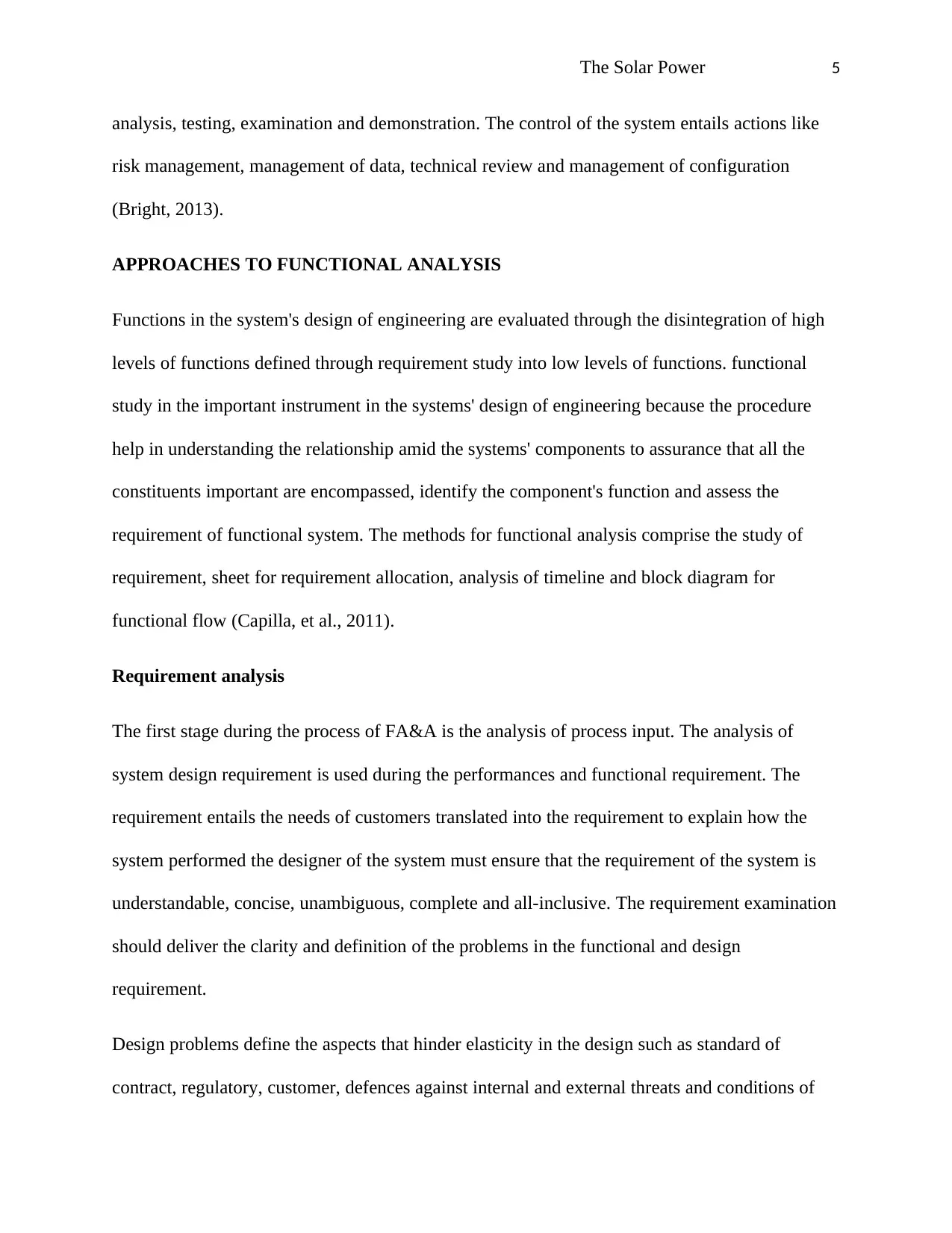
The Solar Power 5
analysis, testing, examination and demonstration. The control of the system entails actions like
risk management, management of data, technical review and management of configuration
(Bright, 2013).
APPROACHES TO FUNCTIONAL ANALYSIS
Functions in the system's design of engineering are evaluated through the disintegration of high
levels of functions defined through requirement study into low levels of functions. functional
study in the important instrument in the systems' design of engineering because the procedure
help in understanding the relationship amid the systems' components to assurance that all the
constituents important are encompassed, identify the component's function and assess the
requirement of functional system. The methods for functional analysis comprise the study of
requirement, sheet for requirement allocation, analysis of timeline and block diagram for
functional flow (Capilla, et al., 2011).
Requirement analysis
The first stage during the process of FA&A is the analysis of process input. The analysis of
system design requirement is used during the performances and functional requirement. The
requirement entails the needs of customers translated into the requirement to explain how the
system performed the designer of the system must ensure that the requirement of the system is
understandable, concise, unambiguous, complete and all-inclusive. The requirement examination
should deliver the clarity and definition of the problems in the functional and design
requirement.
Design problems define the aspects that hinder elasticity in the design such as standard of
contract, regulatory, customer, defences against internal and external threats and conditions of
analysis, testing, examination and demonstration. The control of the system entails actions like
risk management, management of data, technical review and management of configuration
(Bright, 2013).
APPROACHES TO FUNCTIONAL ANALYSIS
Functions in the system's design of engineering are evaluated through the disintegration of high
levels of functions defined through requirement study into low levels of functions. functional
study in the important instrument in the systems' design of engineering because the procedure
help in understanding the relationship amid the systems' components to assurance that all the
constituents important are encompassed, identify the component's function and assess the
requirement of functional system. The methods for functional analysis comprise the study of
requirement, sheet for requirement allocation, analysis of timeline and block diagram for
functional flow (Capilla, et al., 2011).
Requirement analysis
The first stage during the process of FA&A is the analysis of process input. The analysis of
system design requirement is used during the performances and functional requirement. The
requirement entails the needs of customers translated into the requirement to explain how the
system performed the designer of the system must ensure that the requirement of the system is
understandable, concise, unambiguous, complete and all-inclusive. The requirement examination
should deliver the clarity and definition of the problems in the functional and design
requirement.
Design problems define the aspects that hinder elasticity in the design such as standard of
contract, regulatory, customer, defences against internal and external threats and conditions of
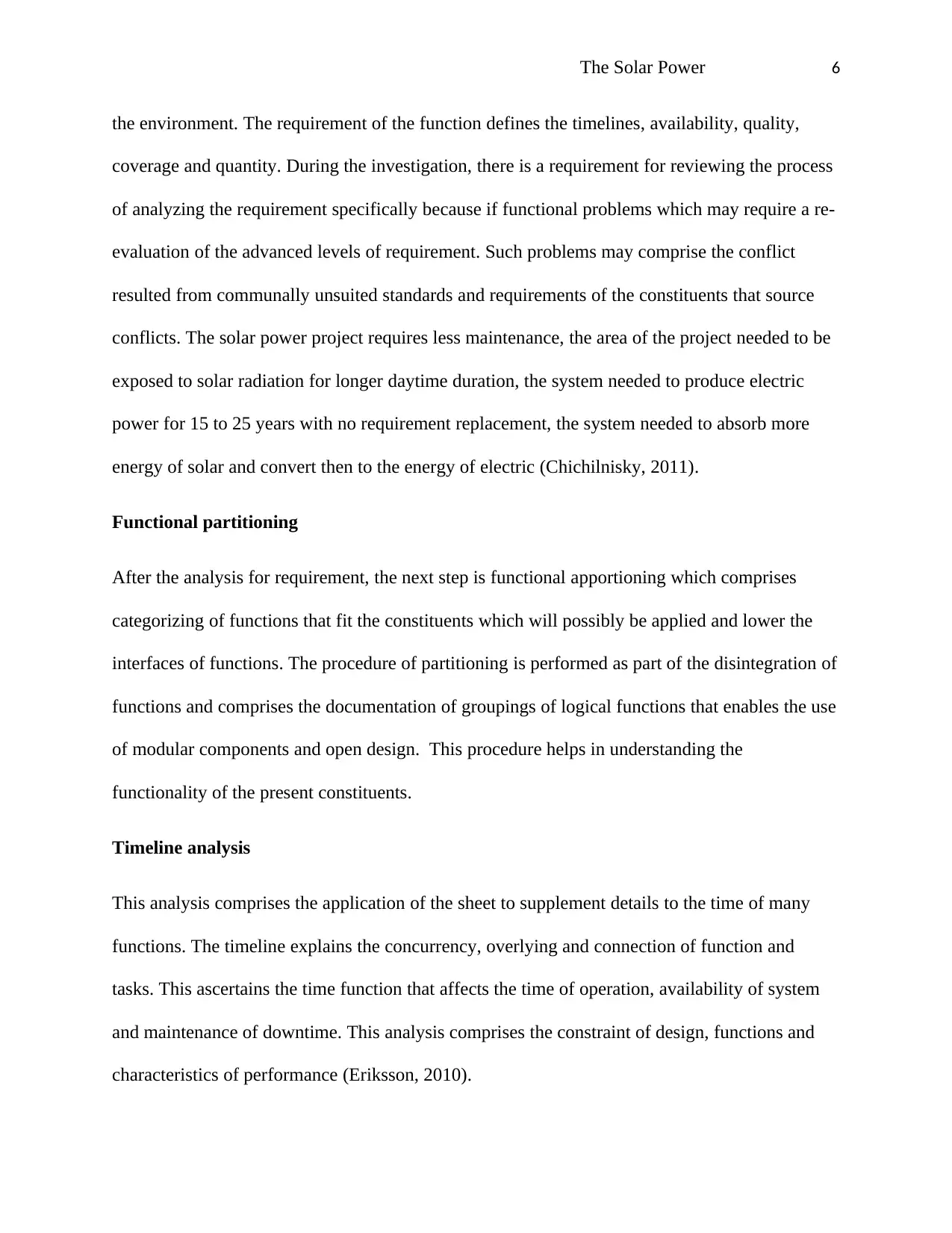
The Solar Power 6
the environment. The requirement of the function defines the timelines, availability, quality,
coverage and quantity. During the investigation, there is a requirement for reviewing the process
of analyzing the requirement specifically because if functional problems which may require a re-
evaluation of the advanced levels of requirement. Such problems may comprise the conflict
resulted from communally unsuited standards and requirements of the constituents that source
conflicts. The solar power project requires less maintenance, the area of the project needed to be
exposed to solar radiation for longer daytime duration, the system needed to produce electric
power for 15 to 25 years with no requirement replacement, the system needed to absorb more
energy of solar and convert then to the energy of electric (Chichilnisky, 2011).
Functional partitioning
After the analysis for requirement, the next step is functional apportioning which comprises
categorizing of functions that fit the constituents which will possibly be applied and lower the
interfaces of functions. The procedure of partitioning is performed as part of the disintegration of
functions and comprises the documentation of groupings of logical functions that enables the use
of modular components and open design. This procedure helps in understanding the
functionality of the present constituents.
Timeline analysis
This analysis comprises the application of the sheet to supplement details to the time of many
functions. The timeline explains the concurrency, overlying and connection of function and
tasks. This ascertains the time function that affects the time of operation, availability of system
and maintenance of downtime. This analysis comprises the constraint of design, functions and
characteristics of performance (Eriksson, 2010).
the environment. The requirement of the function defines the timelines, availability, quality,
coverage and quantity. During the investigation, there is a requirement for reviewing the process
of analyzing the requirement specifically because if functional problems which may require a re-
evaluation of the advanced levels of requirement. Such problems may comprise the conflict
resulted from communally unsuited standards and requirements of the constituents that source
conflicts. The solar power project requires less maintenance, the area of the project needed to be
exposed to solar radiation for longer daytime duration, the system needed to produce electric
power for 15 to 25 years with no requirement replacement, the system needed to absorb more
energy of solar and convert then to the energy of electric (Chichilnisky, 2011).
Functional partitioning
After the analysis for requirement, the next step is functional apportioning which comprises
categorizing of functions that fit the constituents which will possibly be applied and lower the
interfaces of functions. The procedure of partitioning is performed as part of the disintegration of
functions and comprises the documentation of groupings of logical functions that enables the use
of modular components and open design. This procedure helps in understanding the
functionality of the present constituents.
Timeline analysis
This analysis comprises the application of the sheet to supplement details to the time of many
functions. The timeline explains the concurrency, overlying and connection of function and
tasks. This ascertains the time function that affects the time of operation, availability of system
and maintenance of downtime. This analysis comprises the constraint of design, functions and
characteristics of performance (Eriksson, 2010).
⊘ This is a preview!⊘
Do you want full access?
Subscribe today to unlock all pages.

Trusted by 1+ million students worldwide
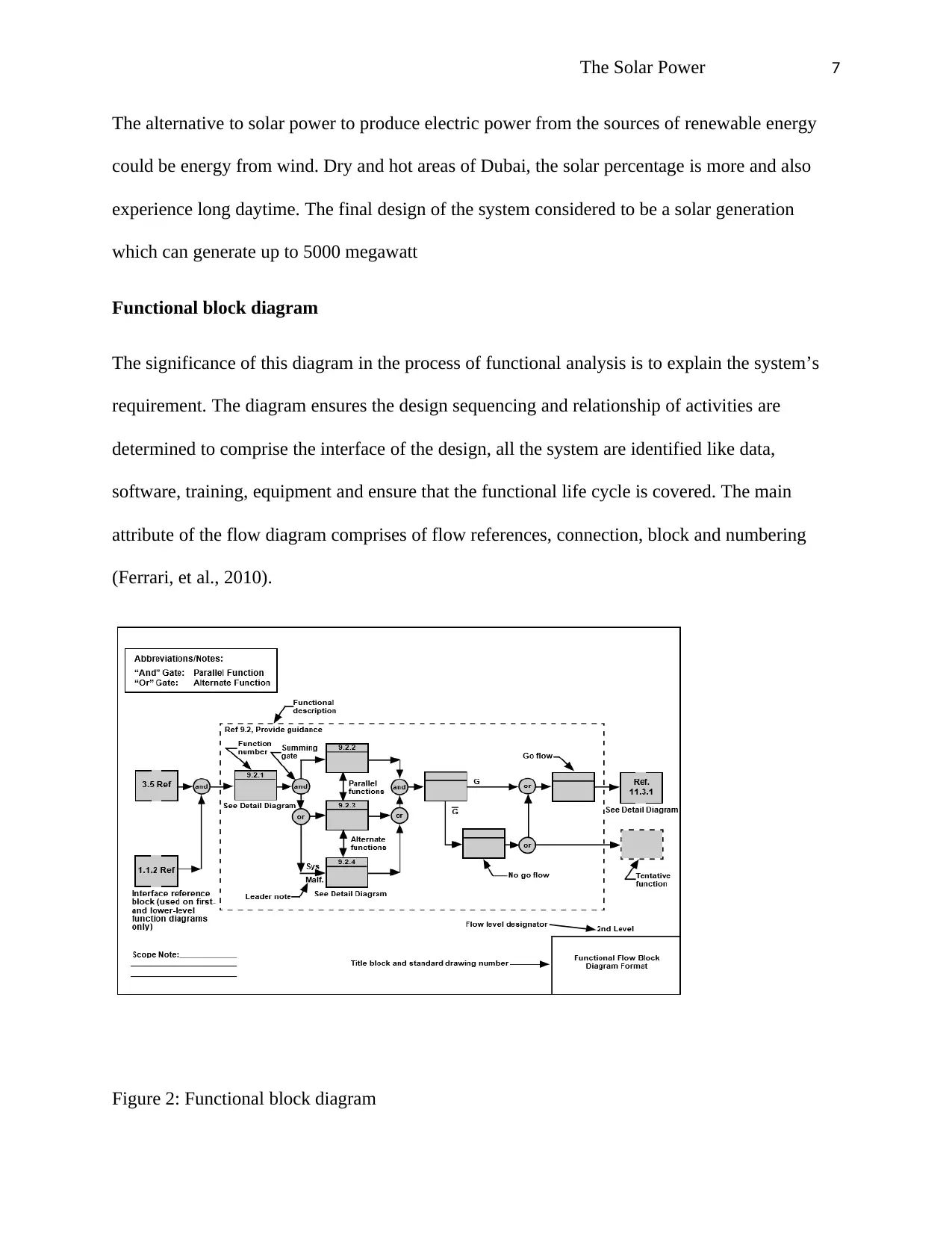
The Solar Power 7
The alternative to solar power to produce electric power from the sources of renewable energy
could be energy from wind. Dry and hot areas of Dubai, the solar percentage is more and also
experience long daytime. The final design of the system considered to be a solar generation
which can generate up to 5000 megawatt
Functional block diagram
The significance of this diagram in the process of functional analysis is to explain the system’s
requirement. The diagram ensures the design sequencing and relationship of activities are
determined to comprise the interface of the design, all the system are identified like data,
software, training, equipment and ensure that the functional life cycle is covered. The main
attribute of the flow diagram comprises of flow references, connection, block and numbering
(Ferrari, et al., 2010).
Figure 2: Functional block diagram
The alternative to solar power to produce electric power from the sources of renewable energy
could be energy from wind. Dry and hot areas of Dubai, the solar percentage is more and also
experience long daytime. The final design of the system considered to be a solar generation
which can generate up to 5000 megawatt
Functional block diagram
The significance of this diagram in the process of functional analysis is to explain the system’s
requirement. The diagram ensures the design sequencing and relationship of activities are
determined to comprise the interface of the design, all the system are identified like data,
software, training, equipment and ensure that the functional life cycle is covered. The main
attribute of the flow diagram comprises of flow references, connection, block and numbering
(Ferrari, et al., 2010).
Figure 2: Functional block diagram
Paraphrase This Document
Need a fresh take? Get an instant paraphrase of this document with our AI Paraphraser
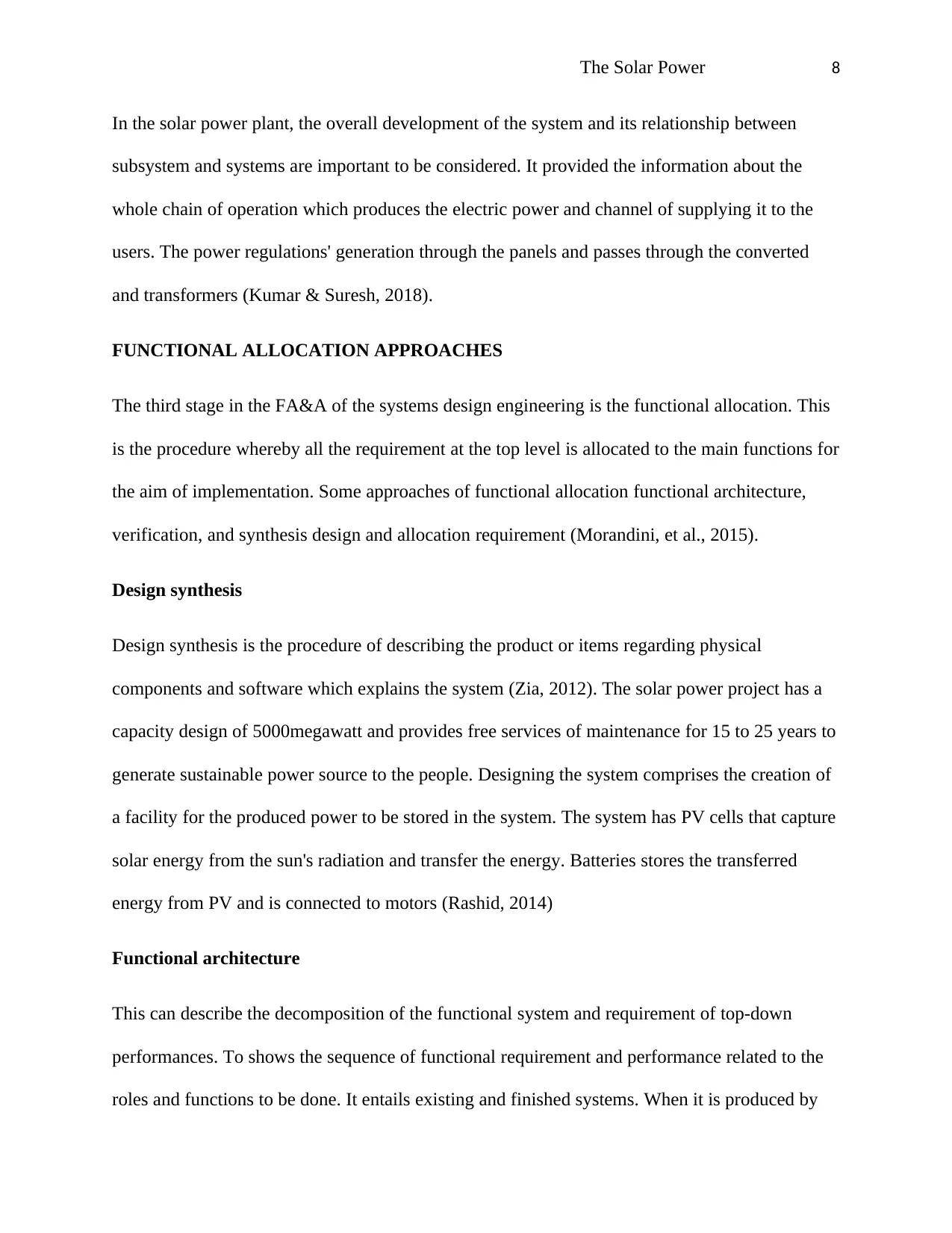
The Solar Power 8
In the solar power plant, the overall development of the system and its relationship between
subsystem and systems are important to be considered. It provided the information about the
whole chain of operation which produces the electric power and channel of supplying it to the
users. The power regulations' generation through the panels and passes through the converted
and transformers (Kumar & Suresh, 2018).
FUNCTIONAL ALLOCATION APPROACHES
The third stage in the FA&A of the systems design engineering is the functional allocation. This
is the procedure whereby all the requirement at the top level is allocated to the main functions for
the aim of implementation. Some approaches of functional allocation functional architecture,
verification, and synthesis design and allocation requirement (Morandini, et al., 2015).
Design synthesis
Design synthesis is the procedure of describing the product or items regarding physical
components and software which explains the system (Zia, 2012). The solar power project has a
capacity design of 5000megawatt and provides free services of maintenance for 15 to 25 years to
generate sustainable power source to the people. Designing the system comprises the creation of
a facility for the produced power to be stored in the system. The system has PV cells that capture
solar energy from the sun's radiation and transfer the energy. Batteries stores the transferred
energy from PV and is connected to motors (Rashid, 2014)
Functional architecture
This can describe the decomposition of the functional system and requirement of top-down
performances. To shows the sequence of functional requirement and performance related to the
roles and functions to be done. It entails existing and finished systems. When it is produced by
In the solar power plant, the overall development of the system and its relationship between
subsystem and systems are important to be considered. It provided the information about the
whole chain of operation which produces the electric power and channel of supplying it to the
users. The power regulations' generation through the panels and passes through the converted
and transformers (Kumar & Suresh, 2018).
FUNCTIONAL ALLOCATION APPROACHES
The third stage in the FA&A of the systems design engineering is the functional allocation. This
is the procedure whereby all the requirement at the top level is allocated to the main functions for
the aim of implementation. Some approaches of functional allocation functional architecture,
verification, and synthesis design and allocation requirement (Morandini, et al., 2015).
Design synthesis
Design synthesis is the procedure of describing the product or items regarding physical
components and software which explains the system (Zia, 2012). The solar power project has a
capacity design of 5000megawatt and provides free services of maintenance for 15 to 25 years to
generate sustainable power source to the people. Designing the system comprises the creation of
a facility for the produced power to be stored in the system. The system has PV cells that capture
solar energy from the sun's radiation and transfer the energy. Batteries stores the transferred
energy from PV and is connected to motors (Rashid, 2014)
Functional architecture
This can describe the decomposition of the functional system and requirement of top-down
performances. To shows the sequence of functional requirement and performance related to the
roles and functions to be done. It entails existing and finished systems. When it is produced by
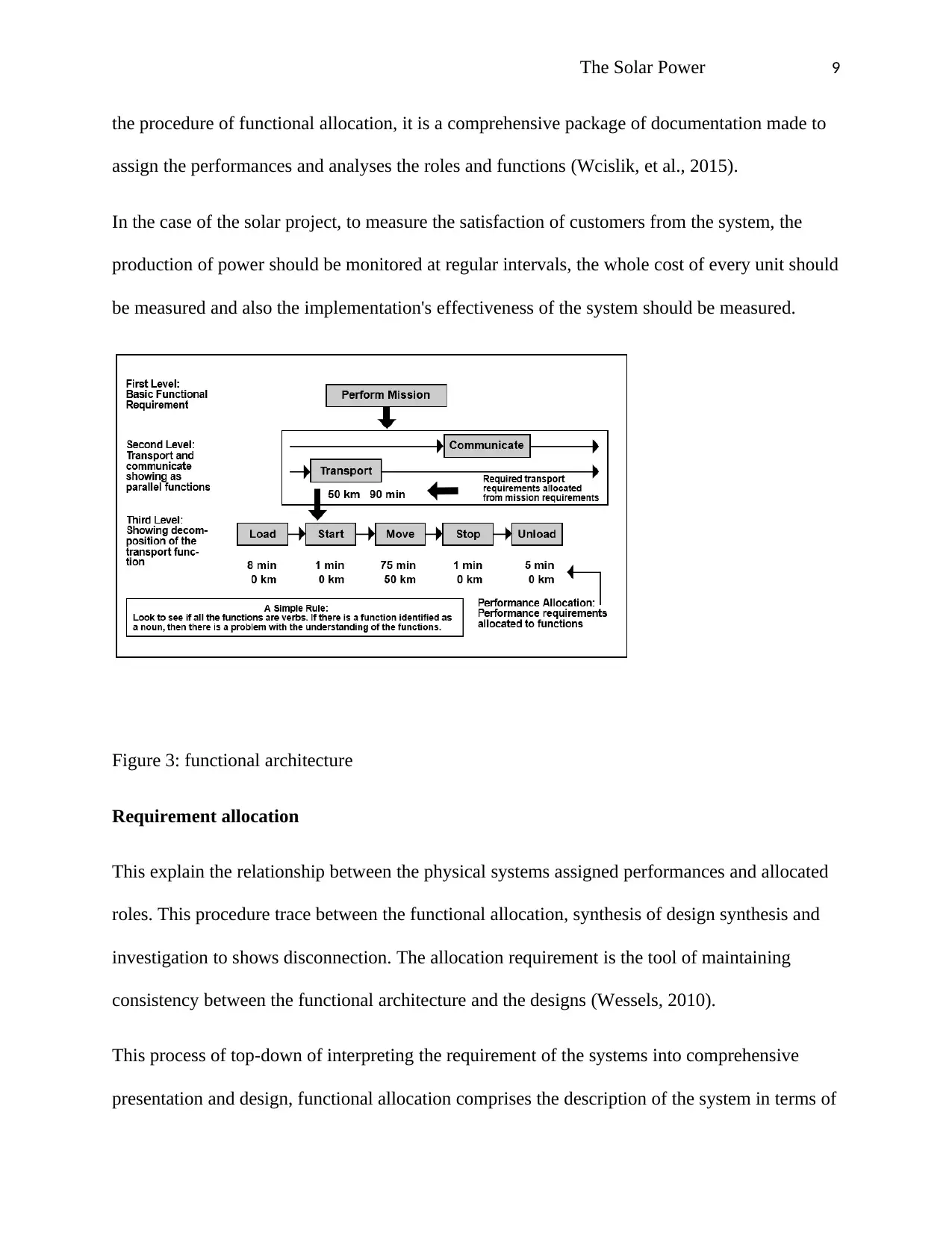
The Solar Power 9
the procedure of functional allocation, it is a comprehensive package of documentation made to
assign the performances and analyses the roles and functions (Wcislik, et al., 2015).
In the case of the solar project, to measure the satisfaction of customers from the system, the
production of power should be monitored at regular intervals, the whole cost of every unit should
be measured and also the implementation's effectiveness of the system should be measured.
Figure 3: functional architecture
Requirement allocation
This explain the relationship between the physical systems assigned performances and allocated
roles. This procedure trace between the functional allocation, synthesis of design synthesis and
investigation to shows disconnection. The allocation requirement is the tool of maintaining
consistency between the functional architecture and the designs (Wessels, 2010).
This process of top-down of interpreting the requirement of the systems into comprehensive
presentation and design, functional allocation comprises the description of the system in terms of
the procedure of functional allocation, it is a comprehensive package of documentation made to
assign the performances and analyses the roles and functions (Wcislik, et al., 2015).
In the case of the solar project, to measure the satisfaction of customers from the system, the
production of power should be monitored at regular intervals, the whole cost of every unit should
be measured and also the implementation's effectiveness of the system should be measured.
Figure 3: functional architecture
Requirement allocation
This explain the relationship between the physical systems assigned performances and allocated
roles. This procedure trace between the functional allocation, synthesis of design synthesis and
investigation to shows disconnection. The allocation requirement is the tool of maintaining
consistency between the functional architecture and the designs (Wessels, 2010).
This process of top-down of interpreting the requirement of the systems into comprehensive
presentation and design, functional allocation comprises the description of the system in terms of
⊘ This is a preview!⊘
Do you want full access?
Subscribe today to unlock all pages.

Trusted by 1+ million students worldwide
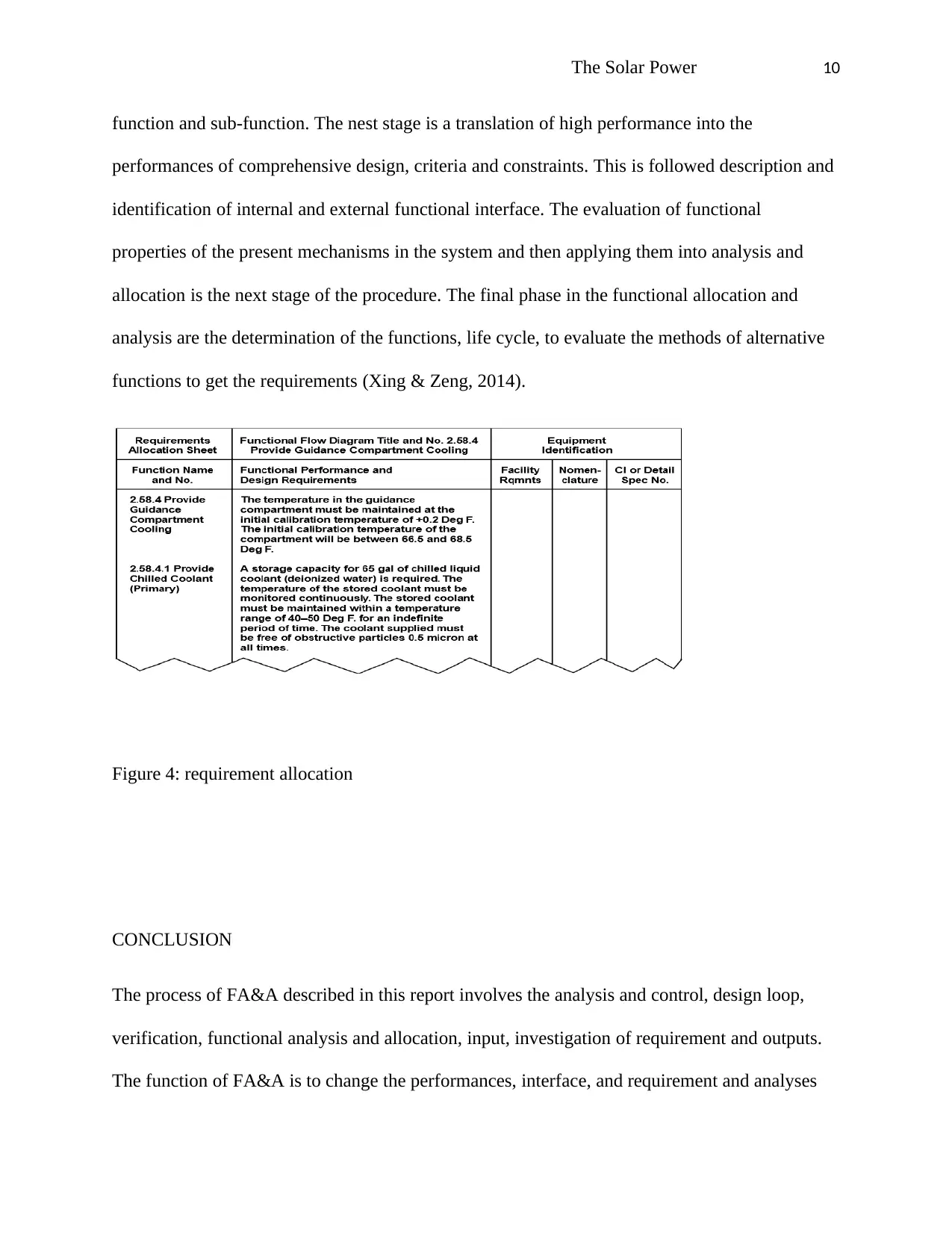
The Solar Power 10
function and sub-function. The nest stage is a translation of high performance into the
performances of comprehensive design, criteria and constraints. This is followed description and
identification of internal and external functional interface. The evaluation of functional
properties of the present mechanisms in the system and then applying them into analysis and
allocation is the next stage of the procedure. The final phase in the functional allocation and
analysis are the determination of the functions, life cycle, to evaluate the methods of alternative
functions to get the requirements (Xing & Zeng, 2014).
Figure 4: requirement allocation
CONCLUSION
The process of FA&A described in this report involves the analysis and control, design loop,
verification, functional analysis and allocation, input, investigation of requirement and outputs.
The function of FA&A is to change the performances, interface, and requirement and analyses
function and sub-function. The nest stage is a translation of high performance into the
performances of comprehensive design, criteria and constraints. This is followed description and
identification of internal and external functional interface. The evaluation of functional
properties of the present mechanisms in the system and then applying them into analysis and
allocation is the next stage of the procedure. The final phase in the functional allocation and
analysis are the determination of the functions, life cycle, to evaluate the methods of alternative
functions to get the requirements (Xing & Zeng, 2014).
Figure 4: requirement allocation
CONCLUSION
The process of FA&A described in this report involves the analysis and control, design loop,
verification, functional analysis and allocation, input, investigation of requirement and outputs.
The function of FA&A is to change the performances, interface, and requirement and analyses
Paraphrase This Document
Need a fresh take? Get an instant paraphrase of this document with our AI Paraphraser

The Solar Power 11
the systems engineering. The approaches include the sheet of allocation requirement, analysis of
timeline and requirement, verification, design synthesis and allocation of requirement. raw
materials for installing solar power plant is zero since the hot and dry climate of Dubai, the days
are long with strong solar radiation, use of solar energy to produce electricity to the individuals
of Dubai is has many advantages. Solar is a renewable energy source, friendly to the
environment, it is easy to harness, reliable, sustainable and can help in meeting the objectives of
a multilateral agreement for environmental conservation such as Kyoto Protocol, UNFCCC and
Paris Agreement.
REFERENCES
116-120, 2010. - Functional Analysis/Allocation and Requirements Flowdown Using Use Case
Realizations. INCOSE International Symposium, Volume 16, pp. 950-964.
the systems engineering. The approaches include the sheet of allocation requirement, analysis of
timeline and requirement, verification, design synthesis and allocation of requirement. raw
materials for installing solar power plant is zero since the hot and dry climate of Dubai, the days
are long with strong solar radiation, use of solar energy to produce electricity to the individuals
of Dubai is has many advantages. Solar is a renewable energy source, friendly to the
environment, it is easy to harness, reliable, sustainable and can help in meeting the objectives of
a multilateral agreement for environmental conservation such as Kyoto Protocol, UNFCCC and
Paris Agreement.
REFERENCES
116-120, 2010. - Functional Analysis/Allocation and Requirements Flowdown Using Use Case
Realizations. INCOSE International Symposium, Volume 16, pp. 950-964.
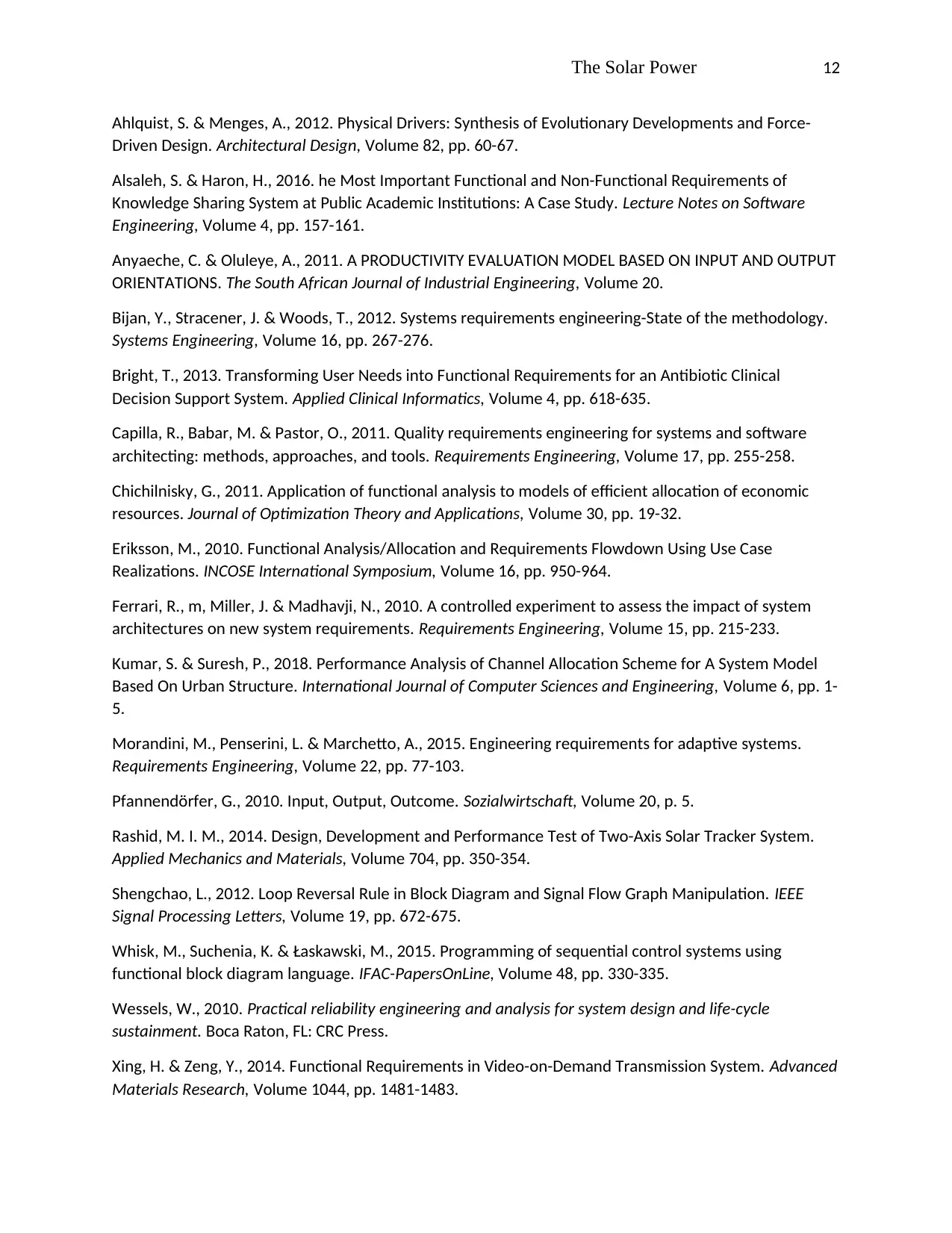
The Solar Power 12
Ahlquist, S. & Menges, A., 2012. Physical Drivers: Synthesis of Evolutionary Developments and Force-
Driven Design. Architectural Design, Volume 82, pp. 60-67.
Alsaleh, S. & Haron, H., 2016. he Most Important Functional and Non-Functional Requirements of
Knowledge Sharing System at Public Academic Institutions: A Case Study. Lecture Notes on Software
Engineering, Volume 4, pp. 157-161.
Anyaeche, C. & Oluleye, A., 2011. A PRODUCTIVITY EVALUATION MODEL BASED ON INPUT AND OUTPUT
ORIENTATIONS. The South African Journal of Industrial Engineering, Volume 20.
Bijan, Y., Stracener, J. & Woods, T., 2012. Systems requirements engineering-State of the methodology.
Systems Engineering, Volume 16, pp. 267-276.
Bright, T., 2013. Transforming User Needs into Functional Requirements for an Antibiotic Clinical
Decision Support System. Applied Clinical Informatics, Volume 4, pp. 618-635.
Capilla, R., Babar, M. & Pastor, O., 2011. Quality requirements engineering for systems and software
architecting: methods, approaches, and tools. Requirements Engineering, Volume 17, pp. 255-258.
Chichilnisky, G., 2011. Application of functional analysis to models of efficient allocation of economic
resources. Journal of Optimization Theory and Applications, Volume 30, pp. 19-32.
Eriksson, M., 2010. Functional Analysis/Allocation and Requirements Flowdown Using Use Case
Realizations. INCOSE International Symposium, Volume 16, pp. 950-964.
Ferrari, R., m, Miller, J. & Madhavji, N., 2010. A controlled experiment to assess the impact of system
architectures on new system requirements. Requirements Engineering, Volume 15, pp. 215-233.
Kumar, S. & Suresh, P., 2018. Performance Analysis of Channel Allocation Scheme for A System Model
Based On Urban Structure. International Journal of Computer Sciences and Engineering, Volume 6, pp. 1-
5.
Morandini, M., Penserini, L. & Marchetto, A., 2015. Engineering requirements for adaptive systems.
Requirements Engineering, Volume 22, pp. 77-103.
Pfannendörfer, G., 2010. Input, Output, Outcome. Sozialwirtschaft, Volume 20, p. 5.
Rashid, M. I. M., 2014. Design, Development and Performance Test of Two-Axis Solar Tracker System.
Applied Mechanics and Materials, Volume 704, pp. 350-354.
Shengchao, L., 2012. Loop Reversal Rule in Block Diagram and Signal Flow Graph Manipulation. IEEE
Signal Processing Letters, Volume 19, pp. 672-675.
Whisk, M., Suchenia, K. & Łaskawski, M., 2015. Programming of sequential control systems using
functional block diagram language. IFAC-PapersOnLine, Volume 48, pp. 330-335.
Wessels, W., 2010. Practical reliability engineering and analysis for system design and life-cycle
sustainment. Boca Raton, FL: CRC Press.
Xing, H. & Zeng, Y., 2014. Functional Requirements in Video-on-Demand Transmission System. Advanced
Materials Research, Volume 1044, pp. 1481-1483.
Ahlquist, S. & Menges, A., 2012. Physical Drivers: Synthesis of Evolutionary Developments and Force-
Driven Design. Architectural Design, Volume 82, pp. 60-67.
Alsaleh, S. & Haron, H., 2016. he Most Important Functional and Non-Functional Requirements of
Knowledge Sharing System at Public Academic Institutions: A Case Study. Lecture Notes on Software
Engineering, Volume 4, pp. 157-161.
Anyaeche, C. & Oluleye, A., 2011. A PRODUCTIVITY EVALUATION MODEL BASED ON INPUT AND OUTPUT
ORIENTATIONS. The South African Journal of Industrial Engineering, Volume 20.
Bijan, Y., Stracener, J. & Woods, T., 2012. Systems requirements engineering-State of the methodology.
Systems Engineering, Volume 16, pp. 267-276.
Bright, T., 2013. Transforming User Needs into Functional Requirements for an Antibiotic Clinical
Decision Support System. Applied Clinical Informatics, Volume 4, pp. 618-635.
Capilla, R., Babar, M. & Pastor, O., 2011. Quality requirements engineering for systems and software
architecting: methods, approaches, and tools. Requirements Engineering, Volume 17, pp. 255-258.
Chichilnisky, G., 2011. Application of functional analysis to models of efficient allocation of economic
resources. Journal of Optimization Theory and Applications, Volume 30, pp. 19-32.
Eriksson, M., 2010. Functional Analysis/Allocation and Requirements Flowdown Using Use Case
Realizations. INCOSE International Symposium, Volume 16, pp. 950-964.
Ferrari, R., m, Miller, J. & Madhavji, N., 2010. A controlled experiment to assess the impact of system
architectures on new system requirements. Requirements Engineering, Volume 15, pp. 215-233.
Kumar, S. & Suresh, P., 2018. Performance Analysis of Channel Allocation Scheme for A System Model
Based On Urban Structure. International Journal of Computer Sciences and Engineering, Volume 6, pp. 1-
5.
Morandini, M., Penserini, L. & Marchetto, A., 2015. Engineering requirements for adaptive systems.
Requirements Engineering, Volume 22, pp. 77-103.
Pfannendörfer, G., 2010. Input, Output, Outcome. Sozialwirtschaft, Volume 20, p. 5.
Rashid, M. I. M., 2014. Design, Development and Performance Test of Two-Axis Solar Tracker System.
Applied Mechanics and Materials, Volume 704, pp. 350-354.
Shengchao, L., 2012. Loop Reversal Rule in Block Diagram and Signal Flow Graph Manipulation. IEEE
Signal Processing Letters, Volume 19, pp. 672-675.
Whisk, M., Suchenia, K. & Łaskawski, M., 2015. Programming of sequential control systems using
functional block diagram language. IFAC-PapersOnLine, Volume 48, pp. 330-335.
Wessels, W., 2010. Practical reliability engineering and analysis for system design and life-cycle
sustainment. Boca Raton, FL: CRC Press.
Xing, H. & Zeng, Y., 2014. Functional Requirements in Video-on-Demand Transmission System. Advanced
Materials Research, Volume 1044, pp. 1481-1483.
⊘ This is a preview!⊘
Do you want full access?
Subscribe today to unlock all pages.

Trusted by 1+ million students worldwide
1 out of 13
Related Documents
Your All-in-One AI-Powered Toolkit for Academic Success.
+13062052269
info@desklib.com
Available 24*7 on WhatsApp / Email
![[object Object]](/_next/static/media/star-bottom.7253800d.svg)
Unlock your academic potential
Copyright © 2020–2025 A2Z Services. All Rights Reserved. Developed and managed by ZUCOL.





